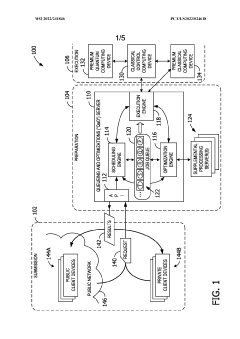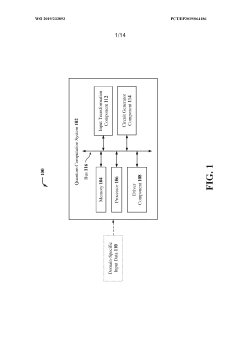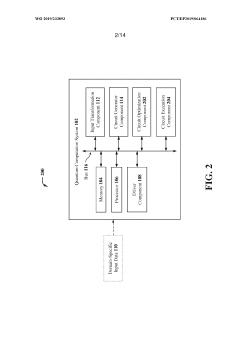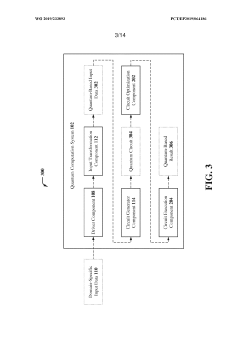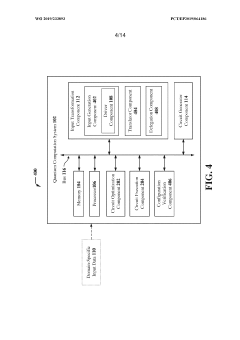Quantum Computing and its Implications for Digital Forensics
JUL 17, 20259 MIN READ
Generate Your Research Report Instantly with AI Agent
Patsnap Eureka helps you evaluate technical feasibility & market potential.
Quantum Computing Evolution and Objectives
Quantum computing has emerged as a revolutionary technology with the potential to transform various fields, including digital forensics. The evolution of quantum computing can be traced back to the early 1980s when Richard Feynman proposed the idea of using quantum mechanical effects to perform computations. Since then, the field has progressed rapidly, driven by advancements in quantum physics, engineering, and computer science.
The development of quantum computing has been marked by several key milestones. In the 1990s, Peter Shor's algorithm demonstrated the theoretical ability of quantum computers to factor large numbers exponentially faster than classical computers, posing a significant challenge to current cryptographic systems. This breakthrough sparked intense interest in quantum computing research and development.
Throughout the 2000s and 2010s, quantum computing hardware saw significant advancements. Superconducting qubits, ion traps, and topological qubits emerged as promising platforms for building quantum processors. Companies like IBM, Google, and D-Wave Systems began developing and commercializing quantum computing systems, making them accessible to researchers and businesses.
The primary objective of quantum computing in the context of digital forensics is to enhance the capabilities of investigators in analyzing and processing large volumes of digital evidence. Quantum computers have the potential to solve complex computational problems that are currently intractable for classical computers, such as breaking encryption, pattern recognition, and data analysis on massive scales.
One of the key goals is to develop quantum algorithms that can efficiently search and analyze vast amounts of unstructured data, a common challenge in digital forensics investigations. Quantum machine learning techniques could potentially revolutionize the way forensic analysts detect patterns, anomalies, and hidden connections within digital evidence.
Another important objective is to address the challenges posed by quantum computing to current cryptographic systems. As quantum computers become more powerful, they threaten to break many of the encryption methods currently used to secure digital communications and data storage. This necessitates the development of quantum-resistant cryptographic algorithms to ensure the integrity and confidentiality of digital evidence.
The field of quantum computing is rapidly evolving, with researchers and companies worldwide working to overcome technical challenges and scale up quantum systems. As quantum computers become more powerful and accessible, their impact on digital forensics is expected to grow significantly, potentially revolutionizing investigative techniques and capabilities in the coming decades.
The development of quantum computing has been marked by several key milestones. In the 1990s, Peter Shor's algorithm demonstrated the theoretical ability of quantum computers to factor large numbers exponentially faster than classical computers, posing a significant challenge to current cryptographic systems. This breakthrough sparked intense interest in quantum computing research and development.
Throughout the 2000s and 2010s, quantum computing hardware saw significant advancements. Superconducting qubits, ion traps, and topological qubits emerged as promising platforms for building quantum processors. Companies like IBM, Google, and D-Wave Systems began developing and commercializing quantum computing systems, making them accessible to researchers and businesses.
The primary objective of quantum computing in the context of digital forensics is to enhance the capabilities of investigators in analyzing and processing large volumes of digital evidence. Quantum computers have the potential to solve complex computational problems that are currently intractable for classical computers, such as breaking encryption, pattern recognition, and data analysis on massive scales.
One of the key goals is to develop quantum algorithms that can efficiently search and analyze vast amounts of unstructured data, a common challenge in digital forensics investigations. Quantum machine learning techniques could potentially revolutionize the way forensic analysts detect patterns, anomalies, and hidden connections within digital evidence.
Another important objective is to address the challenges posed by quantum computing to current cryptographic systems. As quantum computers become more powerful, they threaten to break many of the encryption methods currently used to secure digital communications and data storage. This necessitates the development of quantum-resistant cryptographic algorithms to ensure the integrity and confidentiality of digital evidence.
The field of quantum computing is rapidly evolving, with researchers and companies worldwide working to overcome technical challenges and scale up quantum systems. As quantum computers become more powerful and accessible, their impact on digital forensics is expected to grow significantly, potentially revolutionizing investigative techniques and capabilities in the coming decades.
Digital Forensics Market Trends
The digital forensics market has been experiencing significant growth and transformation in recent years, driven by the increasing complexity of cyber threats and the growing importance of digital evidence in legal proceedings. As organizations and individuals become more reliant on digital technologies, the demand for advanced forensic tools and services continues to rise.
One of the key trends shaping the digital forensics market is the rapid expansion of cloud-based services and storage solutions. This shift has created new challenges for forensic investigators, as evidence is often distributed across multiple servers and jurisdictions. In response, forensic tools are evolving to handle cloud-based data acquisition and analysis more effectively, with a focus on preserving data integrity and maintaining chain of custody.
Mobile device forensics has also emerged as a critical area of growth within the market. With smartphones and tablets becoming ubiquitous, these devices often contain valuable evidence in criminal investigations and civil litigation. As a result, there has been a surge in demand for specialized mobile forensic tools and expertise, capable of extracting and analyzing data from a wide range of devices and operating systems.
The rise of Internet of Things (IoT) devices has introduced another layer of complexity to digital forensics. Connected devices, from smart home appliances to industrial sensors, generate vast amounts of data that can be crucial in investigations. This has led to the development of new forensic techniques and tools specifically designed to handle IoT-generated data, addressing challenges such as diverse data formats and proprietary protocols.
Artificial Intelligence (AI) and Machine Learning (ML) are increasingly being integrated into digital forensic tools and processes. These technologies are enhancing the efficiency and accuracy of evidence analysis, enabling investigators to process large volumes of data more quickly and identify patterns or anomalies that might be missed by human analysts. AI-powered triage systems are also helping prioritize evidence and streamline investigations.
The growing sophistication of cybercrime has necessitated advancements in malware analysis and network forensics. As attackers employ more complex techniques to evade detection, forensic tools are evolving to provide deeper insights into malware behavior and network intrusions. This includes the development of sandboxing technologies and advanced network traffic analysis capabilities.
Regulatory compliance and data privacy concerns are also influencing the digital forensics market. With the implementation of regulations such as GDPR and CCPA, there is an increased focus on privacy-preserving forensic techniques and tools that can operate within legal and ethical boundaries. This has led to the development of more targeted and privacy-conscious forensic approaches.
One of the key trends shaping the digital forensics market is the rapid expansion of cloud-based services and storage solutions. This shift has created new challenges for forensic investigators, as evidence is often distributed across multiple servers and jurisdictions. In response, forensic tools are evolving to handle cloud-based data acquisition and analysis more effectively, with a focus on preserving data integrity and maintaining chain of custody.
Mobile device forensics has also emerged as a critical area of growth within the market. With smartphones and tablets becoming ubiquitous, these devices often contain valuable evidence in criminal investigations and civil litigation. As a result, there has been a surge in demand for specialized mobile forensic tools and expertise, capable of extracting and analyzing data from a wide range of devices and operating systems.
The rise of Internet of Things (IoT) devices has introduced another layer of complexity to digital forensics. Connected devices, from smart home appliances to industrial sensors, generate vast amounts of data that can be crucial in investigations. This has led to the development of new forensic techniques and tools specifically designed to handle IoT-generated data, addressing challenges such as diverse data formats and proprietary protocols.
Artificial Intelligence (AI) and Machine Learning (ML) are increasingly being integrated into digital forensic tools and processes. These technologies are enhancing the efficiency and accuracy of evidence analysis, enabling investigators to process large volumes of data more quickly and identify patterns or anomalies that might be missed by human analysts. AI-powered triage systems are also helping prioritize evidence and streamline investigations.
The growing sophistication of cybercrime has necessitated advancements in malware analysis and network forensics. As attackers employ more complex techniques to evade detection, forensic tools are evolving to provide deeper insights into malware behavior and network intrusions. This includes the development of sandboxing technologies and advanced network traffic analysis capabilities.
Regulatory compliance and data privacy concerns are also influencing the digital forensics market. With the implementation of regulations such as GDPR and CCPA, there is an increased focus on privacy-preserving forensic techniques and tools that can operate within legal and ethical boundaries. This has led to the development of more targeted and privacy-conscious forensic approaches.
Quantum Computing Challenges in Digital Forensics
Quantum computing presents significant challenges to the field of digital forensics, fundamentally altering the landscape of cybersecurity and data analysis. As quantum computers become more powerful and accessible, they pose a direct threat to current encryption methods, potentially rendering many existing forensic techniques obsolete.
One of the primary challenges is the potential for quantum computers to break widely used encryption algorithms. RSA and ECC, which form the backbone of modern secure communications, could be compromised by quantum algorithms such as Shor's algorithm. This capability threatens the integrity of digital evidence, as encrypted data that was once considered secure may become easily accessible to malicious actors with quantum resources.
The speed and processing power of quantum computers also challenge traditional forensic analysis methods. Quantum systems can process vast amounts of data exponentially faster than classical computers, potentially enabling cybercriminals to execute complex attacks or obfuscate their activities more effectively. This increased computational power may necessitate the development of new forensic tools and techniques capable of matching the speed and complexity of quantum-enabled cybercrimes.
Quantum entanglement and superposition introduce new complexities in data storage and transmission. These quantum properties could be exploited to create unbreakable communication channels or develop advanced steganography techniques, making it extremely difficult for forensic investigators to detect or intercept illicit communications.
The concept of quantum supremacy, where quantum computers can solve problems intractable for classical computers, raises concerns about the creation of "quantum-resistant" malware or encryption methods. Such advancements could lead to a new class of cyber threats that are immune to current forensic analysis techniques, requiring a complete overhaul of existing digital forensics methodologies.
Furthermore, the volatile nature of quantum states presents challenges in evidence preservation. The act of measuring or observing a quantum system can alter its state, raising questions about the admissibility and reliability of quantum-based evidence in legal proceedings. Forensic experts must develop new protocols for handling and analyzing quantum data without compromising its integrity.
Lastly, the interdisciplinary nature of quantum computing necessitates a significant shift in the skill set required for digital forensics professionals. Investigators will need to understand complex quantum concepts, requiring extensive training and education to keep pace with this rapidly evolving field. This knowledge gap could lead to a shortage of qualified experts capable of addressing quantum-related cybercrime, potentially impacting the effectiveness of law enforcement and cybersecurity efforts in the quantum era.
One of the primary challenges is the potential for quantum computers to break widely used encryption algorithms. RSA and ECC, which form the backbone of modern secure communications, could be compromised by quantum algorithms such as Shor's algorithm. This capability threatens the integrity of digital evidence, as encrypted data that was once considered secure may become easily accessible to malicious actors with quantum resources.
The speed and processing power of quantum computers also challenge traditional forensic analysis methods. Quantum systems can process vast amounts of data exponentially faster than classical computers, potentially enabling cybercriminals to execute complex attacks or obfuscate their activities more effectively. This increased computational power may necessitate the development of new forensic tools and techniques capable of matching the speed and complexity of quantum-enabled cybercrimes.
Quantum entanglement and superposition introduce new complexities in data storage and transmission. These quantum properties could be exploited to create unbreakable communication channels or develop advanced steganography techniques, making it extremely difficult for forensic investigators to detect or intercept illicit communications.
The concept of quantum supremacy, where quantum computers can solve problems intractable for classical computers, raises concerns about the creation of "quantum-resistant" malware or encryption methods. Such advancements could lead to a new class of cyber threats that are immune to current forensic analysis techniques, requiring a complete overhaul of existing digital forensics methodologies.
Furthermore, the volatile nature of quantum states presents challenges in evidence preservation. The act of measuring or observing a quantum system can alter its state, raising questions about the admissibility and reliability of quantum-based evidence in legal proceedings. Forensic experts must develop new protocols for handling and analyzing quantum data without compromising its integrity.
Lastly, the interdisciplinary nature of quantum computing necessitates a significant shift in the skill set required for digital forensics professionals. Investigators will need to understand complex quantum concepts, requiring extensive training and education to keep pace with this rapidly evolving field. This knowledge gap could lead to a shortage of qualified experts capable of addressing quantum-related cybercrime, potentially impacting the effectiveness of law enforcement and cybersecurity efforts in the quantum era.
Current Quantum-Enhanced Forensic Techniques
01 Quantum Computing Architectures
This category focuses on the design and implementation of quantum computing systems. It includes innovations in qubit arrangements, quantum circuit layouts, and scalable quantum processor architectures. These advancements aim to improve the stability, coherence, and overall performance of quantum computers.- Quantum computing architectures: Various quantum computing architectures are being developed to improve qubit stability, scalability, and error correction. These include superconducting circuits, trapped ions, topological qubits, and photonic systems. Each architecture has its own advantages and challenges in terms of coherence time, gate fidelity, and integration with classical computing systems.
- Quantum error correction and fault tolerance: Quantum error correction techniques are crucial for maintaining the integrity of quantum information in the presence of noise and decoherence. Fault-tolerant quantum computing schemes are being developed to enable large-scale quantum computations. These include surface codes, color codes, and other topological quantum codes that can protect quantum information and allow for reliable quantum operations.
- Quantum algorithms and applications: Quantum algorithms are being developed to solve problems that are intractable for classical computers. These include algorithms for optimization, machine learning, cryptography, and simulation of quantum systems. Potential applications span fields such as drug discovery, financial modeling, and materials science. Researchers are also exploring hybrid quantum-classical algorithms to leverage the strengths of both computing paradigms.
- Quantum communication and networking: Quantum communication technologies aim to enable secure transmission of quantum information over long distances. This includes quantum key distribution for secure cryptography and the development of quantum repeaters for extending the range of quantum networks. Researchers are working on creating quantum internet infrastructures that can connect distributed quantum processors and enable large-scale quantum computing.
- Quantum-classical interface and control systems: Developing efficient interfaces between quantum and classical systems is crucial for the practical implementation of quantum computers. This includes the design of control electronics, readout systems, and software stacks that can translate high-level quantum algorithms into physical qubit operations. Researchers are also working on quantum firmware and operating systems to manage and optimize quantum resources.
02 Quantum Error Correction and Fault Tolerance
This area addresses the challenge of maintaining quantum information integrity in the presence of noise and decoherence. It encompasses techniques for detecting and correcting errors in quantum systems, as well as developing fault-tolerant quantum computing protocols to enhance the reliability of quantum computations.Expand Specific Solutions03 Quantum Algorithms and Applications
This category covers the development of quantum algorithms for various computational problems and their practical applications. It includes innovations in quantum simulation, optimization, machine learning, and cryptography, leveraging the unique properties of quantum systems to achieve computational advantages over classical methods.Expand Specific Solutions04 Quantum-Classical Hybrid Systems
This area focuses on integrating quantum and classical computing technologies to create hybrid systems. It includes methods for efficient data exchange between quantum and classical processors, optimizing resource allocation, and developing algorithms that leverage the strengths of both paradigms to solve complex problems.Expand Specific Solutions05 Quantum Hardware and Control Systems
This category encompasses innovations in quantum hardware components and control systems. It includes advancements in qubit technologies, quantum gates, readout mechanisms, and precision control techniques for manipulating quantum states. These developments aim to improve the fidelity and scalability of quantum computing systems.Expand Specific Solutions
Key Quantum Computing and Digital Forensics Players
The quantum computing landscape is evolving rapidly, with significant implications for digital forensics. The industry is in its early stages, characterized by intense research and development efforts from both established tech giants and specialized quantum startups. While the market size is still relatively small, it's projected to grow exponentially in the coming years. Companies like IBM, Google, and Intel are leading the charge in hardware development, while startups like Origin Quantum and Ruban Quantum are focusing on software and applications. The technology's maturity varies across different aspects, with quantum communication being more advanced than full-scale quantum computers. Universities and research institutions like Delft University of Technology and Johns Hopkins University are also playing crucial roles in advancing the field, particularly in areas relevant to digital forensics.
Intel Corp.
Technical Solution: Intel's quantum computing efforts are centered around their Horse Ridge cryogenic control chip, which aims to address the scalability challenges of quantum systems[8]. This technology could potentially enable more powerful quantum computers capable of processing complex forensic data. Intel is also developing spin qubit technology, which operates at higher temperatures than superconducting qubits, potentially making quantum systems more practical for forensic applications[9]. Their research includes exploring quantum-inspired algorithms that can run on classical hardware to improve digital forensic techniques in the near term[10].
Strengths: Focus on practical, scalable quantum technologies. Weaknesses: Less advanced in pure quantum computing compared to some competitors, which may limit immediate applications in digital forensics.
Origin Quantum Computing Technology (Hefei) Co., Ltd.
Technical Solution: Origin Quantum is focusing on developing indigenous quantum computing technology in China, with potential applications in digital forensics. They have successfully developed a 6-qubit superconducting quantum chip and are working on scaling up their systems[15]. The company is exploring quantum algorithms for data encryption and decryption, which could have significant implications for digital forensics and cybersecurity[16]. Origin Quantum is also researching quantum-resistant cryptographic methods to protect sensitive forensic data in the post-quantum era[17].
Strengths: Rapidly advancing quantum technology in China, potential for unique approaches to quantum forensics. Weaknesses: Less established in the global quantum computing market, which may limit international collaboration and knowledge sharing.
Quantum Algorithms for Digital Evidence Analysis
System and method of in-queue optimizations for quantum cloud computing
PatentWO2022231846A1
Innovation
- A quantum computing system with a queueing and optimizations (QaO) server that performs in-queue optimizations, including prediction models for execution times and machine calibration, to improve the quality of quantum circuit execution, reduce wait times, and balance performance characteristics, utilizing both intra-job and inter-job optimizations to enhance fidelity and throughput.
Quantum computations of classical specifications
PatentWO2019233893A1
Innovation
- A system comprising a processor and memory that transforms domain-specific input data into quantum-based data, generates quantum circuits, and executes them without relying on remote quantum resources, allowing for various domain-specific classical computation software to be used as front-ends and enabling configuration validation.
Quantum-Resistant Cryptography in Digital Forensics
Quantum-resistant cryptography is emerging as a critical field in digital forensics as the advent of quantum computing threatens traditional encryption methods. As quantum computers become more powerful, they have the potential to break many of the cryptographic systems currently used to secure digital evidence and communications. This poses significant challenges for digital forensics practitioners who rely on the integrity and confidentiality of digital data.
The primary focus of quantum-resistant cryptography in digital forensics is to develop and implement encryption algorithms that can withstand attacks from both classical and quantum computers. These post-quantum cryptographic methods aim to ensure that digital evidence remains secure and admissible in legal proceedings, even in the face of advanced quantum computing capabilities.
One of the key approaches in quantum-resistant cryptography is the use of lattice-based cryptography. This method relies on the computational difficulty of solving certain mathematical problems related to high-dimensional lattices. Lattice-based cryptosystems are considered promising candidates for post-quantum cryptography due to their resistance to known quantum algorithms.
Another important area of research is hash-based cryptography, which focuses on developing digital signature schemes that remain secure even against quantum attacks. These schemes are based on the security of cryptographic hash functions, which are believed to be resistant to quantum computing attacks.
Multivariate cryptography is also being explored as a potential solution for quantum-resistant encryption in digital forensics. This approach uses systems of multivariate polynomial equations over finite fields, which are computationally difficult to solve, even for quantum computers.
The implementation of quantum-resistant cryptography in digital forensics tools and processes is crucial for maintaining the long-term security of digital evidence. Forensic practitioners must adapt their methodologies to incorporate these new encryption techniques, ensuring that evidence collection, storage, and analysis remain secure in the quantum era.
Furthermore, the development of quantum-resistant cryptography has implications for the entire chain of custody in digital forensics. From the initial seizure of digital devices to the presentation of evidence in court, every step must be protected against potential quantum attacks to maintain the integrity and admissibility of the evidence.
As quantum computing continues to advance, the field of digital forensics must evolve in parallel, embracing quantum-resistant cryptography to safeguard the future of cybercrime investigations and digital evidence handling. This proactive approach will be essential in maintaining the effectiveness and reliability of digital forensics in the face of emerging quantum technologies.
The primary focus of quantum-resistant cryptography in digital forensics is to develop and implement encryption algorithms that can withstand attacks from both classical and quantum computers. These post-quantum cryptographic methods aim to ensure that digital evidence remains secure and admissible in legal proceedings, even in the face of advanced quantum computing capabilities.
One of the key approaches in quantum-resistant cryptography is the use of lattice-based cryptography. This method relies on the computational difficulty of solving certain mathematical problems related to high-dimensional lattices. Lattice-based cryptosystems are considered promising candidates for post-quantum cryptography due to their resistance to known quantum algorithms.
Another important area of research is hash-based cryptography, which focuses on developing digital signature schemes that remain secure even against quantum attacks. These schemes are based on the security of cryptographic hash functions, which are believed to be resistant to quantum computing attacks.
Multivariate cryptography is also being explored as a potential solution for quantum-resistant encryption in digital forensics. This approach uses systems of multivariate polynomial equations over finite fields, which are computationally difficult to solve, even for quantum computers.
The implementation of quantum-resistant cryptography in digital forensics tools and processes is crucial for maintaining the long-term security of digital evidence. Forensic practitioners must adapt their methodologies to incorporate these new encryption techniques, ensuring that evidence collection, storage, and analysis remain secure in the quantum era.
Furthermore, the development of quantum-resistant cryptography has implications for the entire chain of custody in digital forensics. From the initial seizure of digital devices to the presentation of evidence in court, every step must be protected against potential quantum attacks to maintain the integrity and admissibility of the evidence.
As quantum computing continues to advance, the field of digital forensics must evolve in parallel, embracing quantum-resistant cryptography to safeguard the future of cybercrime investigations and digital evidence handling. This proactive approach will be essential in maintaining the effectiveness and reliability of digital forensics in the face of emerging quantum technologies.
Legal and Ethical Implications of Quantum Forensics
The advent of quantum computing presents significant legal and ethical challenges in the realm of digital forensics. As quantum technologies advance, they have the potential to both enhance and disrupt traditional forensic practices, necessitating a reevaluation of existing legal frameworks and ethical guidelines.
From a legal perspective, quantum computing's ability to break current encryption methods raises concerns about the admissibility and reliability of digital evidence. Courts may need to establish new standards for quantum-resistant encryption and authentication protocols to ensure the integrity of digital evidence. Additionally, the potential for quantum computers to retroactively decrypt previously secure communications could lead to legal debates surrounding the admissibility of such evidence and the protection of privacy rights.
The extraterritorial nature of quantum computing also presents jurisdictional challenges. As quantum networks can span across borders, determining the applicable laws and regulations for quantum-enabled forensic investigations becomes increasingly complex. International cooperation and harmonization of legal frameworks may be necessary to address these cross-border issues effectively.
Ethically, the use of quantum computing in digital forensics raises questions about privacy and civil liberties. The enhanced capabilities of quantum algorithms to analyze vast amounts of data could lead to more intrusive investigations, potentially infringing on individual privacy rights. Striking a balance between effective law enforcement and protecting personal freedoms will be crucial in developing ethical guidelines for quantum forensics.
Moreover, the potential for quantum computers to simulate complex systems could raise ethical concerns about the reliability and fairness of predictive policing and risk assessment tools. As these technologies become more sophisticated, there is a need to ensure transparency, accountability, and fairness in their application within the criminal justice system.
The development of quantum forensic tools may also exacerbate existing digital divides, as access to quantum technologies is likely to be limited to well-resourced organizations and nations. This disparity could create ethical dilemmas regarding equal access to justice and the potential for technological superiority to influence legal outcomes.
As quantum computing continues to evolve, it is imperative for policymakers, legal experts, and ethicists to collaborate in developing comprehensive frameworks that address these challenges. This may include updating laws to account for quantum capabilities, establishing ethical guidelines for the use of quantum forensic tools, and promoting international cooperation to ensure consistent and fair application of quantum-enabled digital forensics across jurisdictions.
From a legal perspective, quantum computing's ability to break current encryption methods raises concerns about the admissibility and reliability of digital evidence. Courts may need to establish new standards for quantum-resistant encryption and authentication protocols to ensure the integrity of digital evidence. Additionally, the potential for quantum computers to retroactively decrypt previously secure communications could lead to legal debates surrounding the admissibility of such evidence and the protection of privacy rights.
The extraterritorial nature of quantum computing also presents jurisdictional challenges. As quantum networks can span across borders, determining the applicable laws and regulations for quantum-enabled forensic investigations becomes increasingly complex. International cooperation and harmonization of legal frameworks may be necessary to address these cross-border issues effectively.
Ethically, the use of quantum computing in digital forensics raises questions about privacy and civil liberties. The enhanced capabilities of quantum algorithms to analyze vast amounts of data could lead to more intrusive investigations, potentially infringing on individual privacy rights. Striking a balance between effective law enforcement and protecting personal freedoms will be crucial in developing ethical guidelines for quantum forensics.
Moreover, the potential for quantum computers to simulate complex systems could raise ethical concerns about the reliability and fairness of predictive policing and risk assessment tools. As these technologies become more sophisticated, there is a need to ensure transparency, accountability, and fairness in their application within the criminal justice system.
The development of quantum forensic tools may also exacerbate existing digital divides, as access to quantum technologies is likely to be limited to well-resourced organizations and nations. This disparity could create ethical dilemmas regarding equal access to justice and the potential for technological superiority to influence legal outcomes.
As quantum computing continues to evolve, it is imperative for policymakers, legal experts, and ethicists to collaborate in developing comprehensive frameworks that address these challenges. This may include updating laws to account for quantum capabilities, establishing ethical guidelines for the use of quantum forensic tools, and promoting international cooperation to ensure consistent and fair application of quantum-enabled digital forensics across jurisdictions.
Unlock deeper insights with Patsnap Eureka Quick Research — get a full tech report to explore trends and direct your research. Try now!
Generate Your Research Report Instantly with AI Agent
Supercharge your innovation with Patsnap Eureka AI Agent Platform!



